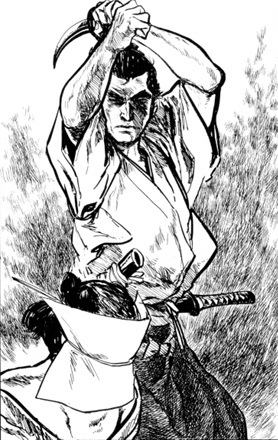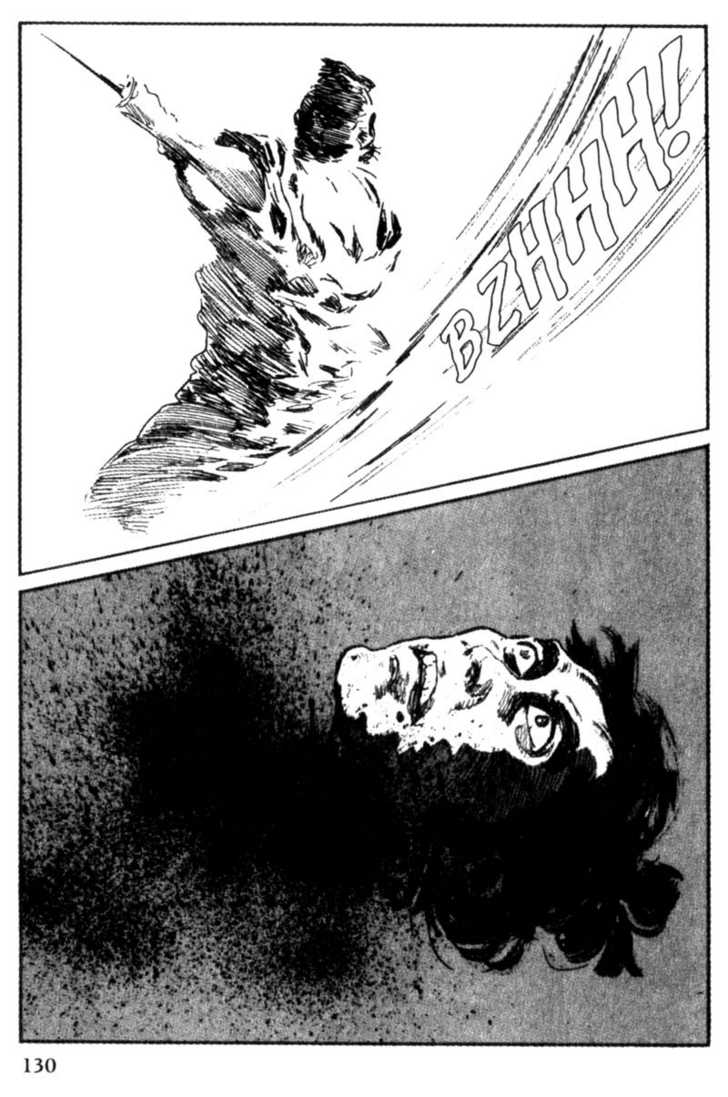Samurai Executioner
by Martin Skidmore 19-Mar-11
I think it’s worth discussing, if only because there seems to be an assumption that Koike & Kojima’s other works are inevitably inferior to their most famous epic, and I honestly think there is far less to choose between them than is generally thought.
 In a way, it seems a little pointless to recommend this series. It’s by Kazuo Koike & Goseki Kojima, and I would imagine that anyone would who had read their Lone Wolf & Cub with any pleasure would have moved on to this, which Dark Horse published in the same small format immediately afterwards. Anyone who didn’t like LW&C is hardly likely to bother with this, and those who haven’t tried Koike & Kojima at all will surely start with LW&C.
In a way, it seems a little pointless to recommend this series. It’s by Kazuo Koike & Goseki Kojima, and I would imagine that anyone would who had read their Lone Wolf & Cub with any pleasure would have moved on to this, which Dark Horse published in the same small format immediately afterwards. Anyone who didn’t like LW&C is hardly likely to bother with this, and those who haven’t tried Koike & Kojima at all will surely start with LW&C.
But I do think it’s worth discussing, if only because there seems to be an assumption that their other works (I may well get onto Path of the Assassin here at some point too) are inevitably inferior to their most famous epic, and I honestly think there is far less to choose between them than is generally thought. This series ran at the same time as LW&C – well, it started two years later, in 1972, but both ended in 1976, this one after about 3,000 pages, barely a third of the other series’ length.
Our main character here is Yamada Asaemon, the Shogun’s sword tester. Swords are generally tested on people, so while Itto Ogami in the other series was the executioner for high-ranking offenders, Yamada Asaemon executes lower-caste criminals. The two series are contemporary, and ultimately cross over in LW&C when Asaemon is sent to kill the rogue samurai Ogami.
 Asaemon’s role is far more sedentary and less open to drama than Ogami’s. Asaemon lives in a government home, and executes criminals. Clearly as a mighty samurai, there is some action here, but a lot of the stories, including my favourites, use the protagonist as a device, a listener to the last words of the condemned, so many of the stories are theirs and only tangentially his. This allows an enormous flexibility to Koike, and he makes the most of it.
Asaemon’s role is far more sedentary and less open to drama than Ogami’s. Asaemon lives in a government home, and executes criminals. Clearly as a mighty samurai, there is some action here, but a lot of the stories, including my favourites, use the protagonist as a device, a listener to the last words of the condemned, so many of the stories are theirs and only tangentially his. This allows an enormous flexibility to Koike, and he makes the most of it.
The fixed base in the capital has another advantage, for me at least. I mentioned in my LW&C piece that Edo (now Tokyo) in that era (17th-19th C) is the time and place in world history that interests me the most. Ogami didn’t get to spend a lot of time in Edo itself, but this is all set there, and Koike’s renowned research and historical accuracy means there are plenty of fascinating insights into that bizarre society.
It has pretty much all the great qualities of LW&C: the intelligent, intense, carefully crafted stories, the raw beauty and energy of the art, the stoic, disciplined, unstoppable samurai lead – perhaps the lack of an overall narrative is the one lack.
But that’s not all a drawback: because there is no overarching story of revenge to follow here, very few of the stories need to be read in any sequence – there are a few that bring back characters and so on (particularly a top cop and his wife), so this is not universally true, but the large majority do work in isolation. I mention this point as a preface to recommending volume 6, in which one of the stories seems to me a genuine miniature masterpiece.
 Japanese comic stories tend towards the long – an episode on a series might be as short as 20 pages, but very short serious stories are rare. Even the magnificent Black Jack series by Osamu Tezuka rather relies on a grasp of the lead character – it’s a series much more than it is self-contained stories. ‘To Be A Sunflower’ here is preceded by a story of 105 pages, but itself runs to just 15, and is one of those where the focus is on the criminal rather than the executioner (who doesn’t get a single line in this). It has just three scenes, and the first, of a man being let through the closed city gates at night, had my jaw dropping, and it never falters from there on, through the man’s brutal murders and his final moments with the executioner around whom the series is centred. There is no name, personal history, friends or family, reason for his crimes, narrative of their sequence or how they started, nor how he is caught, tried and sentenced.
Japanese comic stories tend towards the long – an episode on a series might be as short as 20 pages, but very short serious stories are rare. Even the magnificent Black Jack series by Osamu Tezuka rather relies on a grasp of the lead character – it’s a series much more than it is self-contained stories. ‘To Be A Sunflower’ here is preceded by a story of 105 pages, but itself runs to just 15, and is one of those where the focus is on the criminal rather than the executioner (who doesn’t get a single line in this). It has just three scenes, and the first, of a man being let through the closed city gates at night, had my jaw dropping, and it never falters from there on, through the man’s brutal murders and his final moments with the executioner around whom the series is centred. There is no name, personal history, friends or family, reason for his crimes, narrative of their sequence or how they started, nor how he is caught, tried and sentenced.
There’s not much of anything in it by way of plot, but the control and judgement in what is there is magnificent. It’s a piece about tone, atmosphere, mood, expression, composition, line, light – the switch from the first two night scenes to the blazing sun in the final scene is breathtaking, and the first two-shot of our protagonist and his executioner (above right), just two figures in the sunlight, is drawing as good as you’ll see anywhere in comics – as is the extraordinary bleached-out penultimate panel, of the sword swinging (lower right).
Listen, this doesn’t take but a couple of minutes to read – 15 pages, just 25 word balloons, none of them long. Even if you don’t want to buy the volume and your library doesn’t have it, go to a large comic shop and pick up Samurai Executioner #6, turn to page 115, and read it. I regard this as one of the three best short stories I’ve ever read in comics: the Feldstein/Krigstein ‘Master Race’ is justly celebrated, but this reminds me most in control and mood of my favourite war story, by Bob Kanigher and Alex Toth, called ‘White Devil, Yellow Devil’ (which you can find reprinted cheaply in Sgt Rock Special 8). It’s amazing that comics hasn’t produced more great shorts, but they are surprisingly rare, and you shouldn’t miss one that might well be one of the greatest. If you aren’t already a fan of Koike & Kojima’s work, then either this converts you, or you may as well forget about them.
Tags: goseki kojima, kazuo koike, lone wolf & cub, Manga, Samurai Executioner
I wondering how to get published my own manga comic book?
Now I have my comic book done it just need to get published.
Can you help getting my work published?
Thanks you
I’m sorry, we don’t really have the industry contacts to be able to help. Good luck!